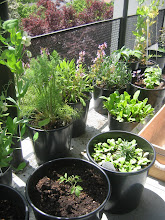Saturday, November 6, 2010
Wears Like Iron
Among many other family artifacts my Mom sent out to Portland were a couple cast iron pans. I got 'em, cuz my sibs are already fixed for that kind of stuff.
These weren't the first ones I've owned- in the last year or so I picked up 2 excellent ones at goodwill. Of course, the ones Mom sent have personal value due to their being the ones Dad used since Idunnowhen, but there are things I like about the goodwill finds too. They came from goodwill, duh, so they're awesome. I think I paid about 8 bucks a piece for them, which is about what they would have cost new. In another class of item (hellllooo!?! IKEA svalka wineglasses retail at $4.99 a 6-pack-don't think I'm gonna pay 99 cents each for a bunch of dinged up ones!), paying the same as for a new one would be foolish. In a cast-iron pan, years of hard use are a material advantage. The skillet on the right rear burner also has the inscription "D. Baldyy" scratched into the oxidized material of the handle. At least, I think that's what it says. I couldn't say why I like that so much. The pan in front of it I got a couple weeks ago. It's smaller, and weighs a lot less. Also, it's ambidextrously cast, that is, it has pouring "ears" on both sides. Baldyy has a spout only on the left side, which means it assumes that you'll pick it up with your right hand. Since it weighs a ton, and I'm right handed, that makes a certain amount of sense until I go to scrape the pan out and realize that I'm clumsy with a spatula in my left hand. I'd rather lift left-handed and scoop right. Dweebity, whatever. The little pan works well either way and is a pound or more lighter.
On the left are the pans mom sent. In front is a skillet that, while it is the same diameter as the larger of my goodwill scores, still weighs less. This runs with what I've heard about vintage cast iron: that one of the desirable features of some really old pieces is that it was cast in thinner molds. They have the same dimensions and durability as newer items, but are easier to sling around. This one was coated with dust & polymerized grease, and had a couple mouse turds adhered to it for lagniappe. Oh yeah. Plus, it's also got the two spouts. The thing in the back is larger and deeper than I think I'm ever likely to need, but I might try making bread in it. The seasoning on it had degraded pretty badly and it was showing a lot of rust when Jej pulled it out of the box. Does anybody remember if Dad used that thing to cook his picnic hams? Or bake bread in? Anyway, it's a no-foolin' piece of ironmongery.
So what did I want to take on these grotty old things for? It took about half an hour of elbow grease, baking soda, and cooking oil to get those 2 pans back in really decent shape. I'm pretty confident that they'll cook really well when I try them out, but it was kind of an effort.
Because they are simply better than anything else at what they do. There's a reason there are so many teflon pans at goodwill- the damn things wear out. They also aren't safe at high temperatures. You heat up a teflon pan under a broiler and everything you eat is gonna get a nonstick coating. You could invest in fancy enamel LeCreuset or some shit. I mean, I love mine, but again- I thrifted it. Enamel is easy to clean and safe at high temperatures, but once you whang a hole in it, you might as well throw the pan out, and some of that stuff is mighty costive. Or you could buy stainless. You'd pay the same or nearly as much for All-Clad, or something else that would give you equally good heat distribution, and you'd save on weight. Or you could pay a tenth the amount for cast iron. At any rate, unlike either teflon or enamel, the nonstick coating that develops on a cast-iron pan is continuously self-repairing. I think that's the feature that beats the heck out of all other choices for me. Low-tech beats high tech on safety, durability, and effectiveness, plus throws in the magic Accio Reparo! function at the end. I love that.
Labels:
cooking,
cooking tools,
geek,
goodwill,
harry potter,
thrift stores
Subscribe to:
Post Comments (Atom)







No comments:
Post a Comment